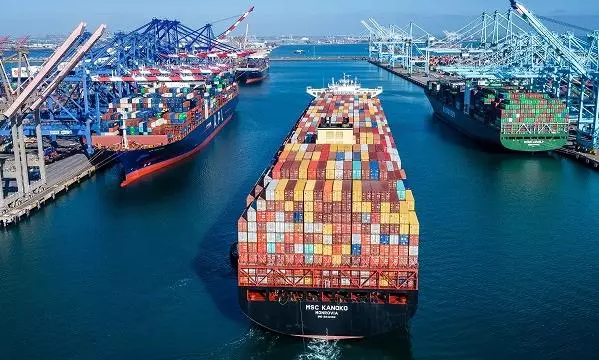Downward pressure on spot rates: supply or demand?
While container freight spot rates are dropping, U.S. imports continue to be strong.

Is the downward pressure on container freight spot rates due to reduced supply or demand?
"As the demand data (as an example published by Container Trade Statistics) is notoriously time-lagged, we used our timely and forward-looking supply side data to see if there was an extraordinary spike in deployed capacity, which could offer an explanation to this decrease," says the latest report from Sea-Intelligence.
Figure 1 shows both the Y/Y capacity growth and the annualised capacity growth (versus 2019) for Asia-North America West Coast while figure 2 shows the same for Asia-North Europe.
For the Asia-North America West Coast, the developments are quite curious, says the report. "Ballooning of capacity could have framed a case for dropping spot rates, but since the annualised growth has been under 5 percent, it seems as if the current downwards trend is informed by a decrease on the demand side. This in itself should be quite worrying for the carriers, especially as we are headed into the traditional peak season. This is possibly an indication that the market is not as strong as expected."
Even on the Asia-North Europe route, both sets of capacity growth figures have been fluctuating around the 0 percent mark, indicating that the downward pressure on spot rates is not supply-driven and the market is not as strong as initially expected for the 2022 peak season, says the report.
While Asia-US West Coast prices are down 31 percent from last year, Asia-US East Coast prices are down 29 percent lower than last year, according to the latest weekly update from Freightos.
"More signs of slowing consumer demand surfaced this week with reports of manufacturing and new orders slowing and of US retail spending unexpectedly dipping slightly in May," says the update.
Shippers are seeing spot rates and premium surcharges fall in many trades, and getting capacity allocations is becoming easier, Xeneta said in its report last month.
U.S. imports continue to be strong
Now, here's the contrast: The ports of Los Angeles and Long Beach, which handle around 40 percent of U.S. container imports, have reported strong volumes in the first five months of 2022.
The Port of Los Angeles processed 967,900 TEUs in May, the third best overall month in its 115-year history. "Five months into 2022, the port has processed more than 4.5 million TEUs, equal to last year's record-setting pace," says an official statement.
The Port of Long Beach had its second-busiest month on record in May, and its strongest so far in 2022. The port processed 890,989 TEUs in May, a 2 percent decline from May 2021, which remains the port's busiest month in its 111-year history.
There were 24 container ships still waiting for anchor outside the LA/LB ports on July 5, according to data from Captain J. Kipling (Kip) Louttit, Executive Director, Marine Exchange of Southern California & Vessel Traffic Service Los Angeles and Long Beach San Pedro, CA.
"The 24 container ships in the backup are 85 fewer than the record of 109 on January 9. Thus, we're down to less than 1/4 of the record backup."
The Port of New York and New Jersey moved 845,305 TEUs in May 2022, the second-busiest month of cargo activity in the port's history. The May 2022 cargo volume was up over 31 percent compared to May 2019 and up over 5 percent compared to April 2022 when the seaport handled 802,963 TEUs.
The Port of Savannah handled more than 519,000 TEUs in May, a record, an increase of over 8 percent.



